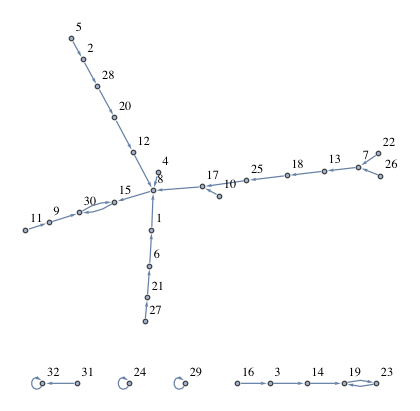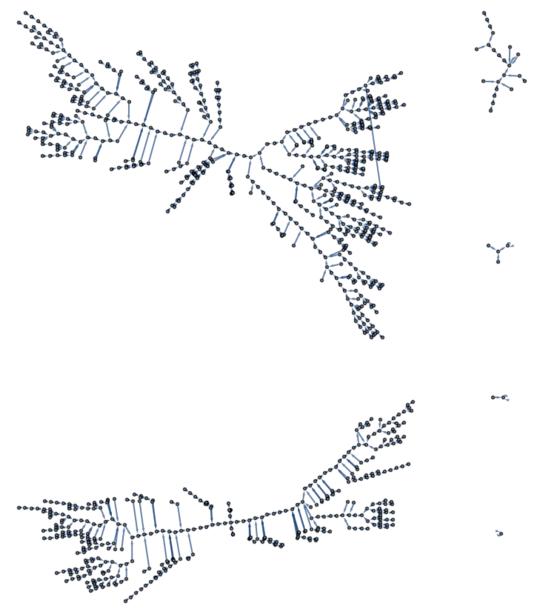8
Task
You must write a program or function in the language of your choice which accurately counts the number of terminal cycles of a simple directed graph.
This particular kind of directed graph is represented as an array of n integers, each with an independently-chosen random value between 1 and n (or 0 and n-1, if your language counts from 0). The graph can be thought of as arrows pointing from one index (node) to an index which matches the value found at the starting index.
Your function must be capable of accepting large graphs, up to n=1024, or any smaller integer size.
Example
Consider this graph for n=10:
[9, 7, 8, 10, 2, 6, 3, 10, 6, 8]
Index 1 contains a 9, so there's an arrow from index 1 to index 9. Index 9 contains a 6, so there's an arrow 9 -> 6. Index 6 contains 6, which is a terminal cycle, pointing back to itself.
Index 2 contains a 7. Index 7 contains a 3. Index 3 contains an 8. Index 8 contains a 10. Index 10 contains an 8, so that's a second terminal cycle (8 -> 10 -> 8 -> 10, etc.).
Index 4 -> 10, which enters the second terminal cycle. Likewise, index 5 -> 2 -> 7 -> 3 -> 8, which is also part of the second terminal cycle.
At this point, all indices (nodes) have been checked, all paths have been followed, and two unique terminal cycles are identified. Therefore, the function should return 2, since that is the number of terminal cycles in this directed graph.
Scoring
Aim for the smallest code, but make sure it counts terminal cycles correctly. Shortest code after 1 week wins.
Test Cases
Here's are some test cases to check the correctness of your code. If your language counts array indices starting from 0, you must of course subtract 1 from the value of each array element, to prevent an out-of-bound index.
n=32, 5 cycles:
[8, 28, 14, 8, 2, 1, 13, 15, 30, 17, 9, 8, 18, 19, 30, 3, 8, 25, 23, 12, 6, 7, 19, 24, 17, 7, 21, 20, 29, 15, 32, 32]
n=32, 4 cycles:
[20, 31, 3, 18, 18, 18, 8, 12, 25, 10, 10, 19, 3, 9, 18, 1, 13, 5, 18, 23, 20, 26, 16, 22, 4, 16, 19, 31, 21, 32, 15, 22]
n=32, 3 cycles:
[28, 13, 17, 14, 4, 31, 11, 4, 22, 6, 32, 1, 13, 15, 7, 19, 10, 28, 9, 22, 5, 26, 17, 8, 6, 13, 7, 10, 9, 30, 23, 25]
n=32, 2 cycles:
[25, 23, 22, 6, 24, 3, 1, 21, 6, 18, 20, 4, 8, 5, 16, 10, 15, 32, 26, 25, 27, 14, 13, 12, 9, 9, 29, 8, 13, 31, 32, 1]
n=32, 1 cycle:
[6, 21, 15, 14, 22, 12, 5, 32, 29, 3, 22, 23, 6, 16, 20, 2, 16, 25, 9, 22, 13, 2, 19, 20, 26, 19, 32, 3, 32, 19, 28, 16]
n=32, 1 cycle:
[8, 9, 10, 11, 12, 13, 14, 15, 16, 17, 18, 19, 20, 21, 22, 23, 24, 25, 26, 27, 28, 29, 30, 31, 32, 1, 2, 3, 4, 5, 6, 7]
n=1024, 6 cycles:
[239, 631, 200, 595, 178, 428, 582, 191, 230, 551, 223, 61, 564, 463, 568, 527, 143, 403, 154, 236, 928, 650, 14, 931, 236, 170, 910, 782, 861, 464, 378, 748, 468, 779, 440, 396, 467, 630, 451, 130, 694, 167, 594, 115, 671, 853, 612, 238, 464, 771, 825, 471, 167, 653, 561, 337, 585, 986, 79, 506, 192, 873, 184, 617, 4, 259, 4, 662, 623, 694, 859, 6, 346, 431, 181, 703, 823, 140, 635, 90, 559, 689, 118, 117, 130, 248, 931, 767, 840, 158, 696, 275, 610, 217, 989, 640, 363, 91, 129, 399, 105, 770, 870, 800, 429, 473, 119, 908, 481, 337, 504, 45, 1011, 684, 306, 126, 215, 729, 771, 5, 302, 992, 380, 824, 868, 205, 807, 917, 407, 759, 181, 640, 685, 795, 258, 180, 900, 20, 773, 546, 866, 564, 761, 632, 895, 968, 980, 651, 225, 676, 18, 685, 784, 208, 227, 3, 267, 852, 57, 487, 566, 633, 849, 309, 543, 145, 575, 811, 621, 560, 492, 24, 665, 66, 851, 168, 262, 259, 754, 481, 565, 768, 172, 1012, 241, 3, 370, 985, 389, 82, 779, 744, 829, 836, 249, 975, 909, 840, 226, 867, 499, 192, 909, 972, 735, 252, 785, 545, 486, 186, 1011, 89, 939, 649, 110, 119, 185, 836, 717, 545, 938, 621, 946, 94, 363, 721, 177, 747, 59, 819, 146, 283, 821, 547, 654, 941, 755, 18, 449, 367, 499, 944, 62, 553, 435, 344, 900, 25, 251, 920, 902, 99, 326, 98, 495, 385, 929, 865, 327, 725, 674, 33, 173, 429, 873, 558, 90, 460, 366, 543, 583, 954, 792, 213, 536, 670, 49, 738, 802, 1015, 23, 915, 119, 263, 307, 601, 474, 971, 826, 613, 446, 37, 145, 894, 901, 307, 906, 886, 990, 89, 798, 384, 487, 822, 354, 768, 902, 163, 179, 134, 920, 439, 619, 215, 94, 709, 744, 366, 543, 349, 347, 2, 438, 141, 486, 19, 998, 500, 857, 955, 932, 1, 587, 195, 646, 550, 887, 626, 400, 348, 154, 808, 678, 873, 186, 282, 168, 993, 722, 56, 345, 5, 226, 328, 22, 894, 658, 264, 13, 803, 791, 359, 217, 997, 168, 578, 952, 734, 964, 898, 659, 628, 980, 15, 31, 439, 13, 875, 687, 1004, 1023, 165, 642, 561, 897, 711, 124, 404, 346, 723, 774, 352, 784, 276, 395, 14, 443, 343, 153, 510, 590, 172, 215, 130, 106, 295, 906, 133, 758, 483, 898, 391, 760, 702, 972, 721, 611, 592, 1001, 724, 934, 59, 831, 171, 253, 869, 431, 538, 20, 648, 76, 351, 103, 33, 385, 852, 437, 470, 95, 434, 408, 430, 994, 366, 706, 809, 532, 161, 388, 668, 245, 965, 365, 913, 471, 927, 245, 256, 805, 540, 380, 995, 446, 657, 545, 573, 955, 499, 322, 949, 635, 401, 185, 421, 626, 534, 429, 930, 633, 563, 348, 626, 518, 682, 233, 775, 444, 42, 199, 57, 271, 683, 397, 883, 620, 768, 8, 331, 497, 19, 340, 900, 919, 497, 276, 78, 252, 164, 764, 927, 242, 270, 759, 824, 945, 886, 262, 59, 439, 217, 720, 519, 862, 626, 326, 339, 589, 16, 565, 947, 604, 144, 87, 520, 256, 240, 336, 685, 361, 998, 805, 678, 24, 980, 203, 818, 855, 85, 276, 822, 183, 266, 347, 8, 663, 620, 147, 189, 497, 128, 357, 855, 507, 275, 420, 755, 131, 469, 672, 926, 859, 156, 127, 986, 489, 803, 433, 622, 951, 83, 862, 108, 192, 167, 862, 242, 519, 574, 358, 549, 119, 630, 60, 925, 414, 479, 330, 927, 94, 767, 562, 919, 1011, 999, 908, 113, 932, 632, 403, 309, 838, 341, 179, 708, 847, 472, 907, 537, 516, 992, 944, 615, 778, 801, 413, 653, 690, 393, 452, 394, 596, 545, 591, 136, 109, 942, 546, 57, 626, 61, 587, 862, 829, 988, 965, 781, 849, 843, 815, 60, 928, 784, 388, 341, 491, 565, 83, 110, 164, 38, 1024, 859, 297, 520, 327, 733, 699, 631, 78, 178, 671, 895, 818, 637, 99, 425, 933, 248, 299, 333, 144, 323, 105, 849, 942, 767, 265, 72, 204, 547, 934, 916, 304, 919, 273, 396, 665, 452, 423, 471, 641, 675, 60, 388, 97, 963, 902, 321, 826, 476, 782, 723, 99, 735, 893, 565, 175, 141, 70, 918, 659, 935, 492, 751, 261, 362, 849, 593, 924, 590, 982, 876, 73, 993, 767, 441, 70, 875, 640, 567, 920, 321, 46, 938, 377, 905, 303, 736, 182, 626, 899, 512, 894, 744, 254, 984, 325, 694, 6, 367, 532, 432, 133, 938, 74, 967, 725, 87, 502, 946, 708, 122, 887, 256, 595, 169, 101, 828, 696, 897, 961, 376, 910, 82, 144, 967, 885, 89, 114, 215, 187, 38, 873, 125, 522, 884, 947, 962, 45, 585, 644, 476, 710, 839, 486, 634, 431, 475, 979, 877, 18, 226, 656, 573, 3, 29, 743, 508, 544, 252, 254, 388, 873, 70, 640, 918, 93, 508, 853, 609, 333, 378, 172, 875, 617, 167, 771, 375, 503, 221, 624, 67, 655, 465, 272, 278, 161, 840, 52, 1016, 909, 567, 544, 234, 339, 463, 621, 951, 962, 1019, 383, 523, 279, 780, 838, 984, 999, 29, 897, 564, 762, 753, 393, 205, 31, 150, 490, 156, 796, 586, 676, 773, 465, 489, 1024, 433, 214, 701, 480, 604, 280, 241, 563, 943, 911, 12, 400, 261, 883, 999, 207, 618, 141, 959, 767, 978, 461, 992, 982, 272, 143, 404, 645, 331, 348, 783, 698, 827, 82, 145, 536, 449, 852, 750, 789, 413, 913, 420, 14, 499, 285, 533, 223, 75, 591, 994, 884, 237, 63, 411, 563, 611, 801, 173, 759, 278, 318, 772, 1018, 48, 440, 333, 611, 834, 423, 583, 22, 716, 393, 794, 83, 83, 864, 859, 600, 525, 808, 569, 95, 952, 852, 567, 651, 2, 984, 906, 992, 747, 602, 143, 547, 1008, 940, 245, 633, 378, 193, 771, 965, 648, 437, 873, 591, 664, 271, 777, 274, 742, 68, 429, 825, 144, 55, 272, 279, 6, 400, 485, 66, 311, 663, 441, 23, 988, 726, 48, 624, 302, 617, 120, 653, 810, 641, 142]


Sure, here's a big fat n=1024 test case. Hopefully I didn't butcher it while packaging it for Stack Exchange. – phosgene – 2014-05-04T21:07:07.713
Clarify: If the language uses zero-based arrays, then the numbers in the array will all be zero-based, or not? – Ypnypn – 2014-05-04T21:08:16.203
Yes, that's correct. The numbers in the array will always point to a valid array index. I used the 'human style' counting method of starting from 1 because that's what my language uses, and I didn't want to screw up my examples. – phosgene – 2014-05-04T21:11:42.117